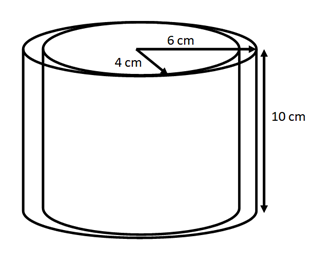
Answer
411k+ views
Hint: Here we need to find the total surface area of a pipe. We know that the pipe is in the shape of a hollow cylinder. So we will use the formula of area of a hollow cylinder to calculate the area of a pipe. We will substitute the value of the outer radius, inner radius and the length in the formula of the hollow cylinder to get the find value of the total surface area of the pipe.
Complete step by step solution:
Here we need to find the total surface area of a pipe. The given pipe is in the shape of a hollow cylinder.
It is given that the outer diameter of a pipe is 6 cm and the inner diameter of a circular pipe is 4 cm.
Now, we will draw the figure using the given information.

We know that the formula for the area of a hollow cylinder is given by
$Area = 2\pi h\left( {{r_2} + {r_1}} \right) + 2\pi \left( {{r_2}^2 - {r_1}^2} \right)$
${r_2} = \dfrac{6}{2}cm = 3cm$ , ${r_1} = \dfrac{4}{2}cm = 2cm$ and $h = 10cm$
Now, we will substitute the value of outer radius, inner radius and the length of a pipe in the formula.
$ \Rightarrow Area = 2 \cdot \pi \cdot 10 \cdot \left( {3 + 2} \right) + 2 \cdot \pi \cdot \left( {{3^2} - {2^2}} \right)$
On simplifying the terms, we get
$ \Rightarrow Area = 2 \cdot \pi \cdot 10 \cdot 5 + 2 \cdot \pi \cdot 5$
On multiplying the terms, we get
$ \Rightarrow Area = 100\pi + 10\pi $
On adding the terms, we get
$ \Rightarrow Area = 110\pi c{m^2}$
Hence, the total surface area of a pipe is equal to $110\pi c{m^2}$.
Hence, the correct answer is option B.
Note:
Remember that the total surface area of a hollow cylinder is equal to lateral surface area and the area of the solid bases. To find the total surface area of a hollow cylinder, we need both outer and inner radii of the hollow cylinder and the length of the hollow cylinder.
Complete step by step solution:
Here we need to find the total surface area of a pipe. The given pipe is in the shape of a hollow cylinder.
It is given that the outer diameter of a pipe is 6 cm and the inner diameter of a circular pipe is 4 cm.
Now, we will draw the figure using the given information.

We know that the formula for the area of a hollow cylinder is given by
$Area = 2\pi h\left( {{r_2} + {r_1}} \right) + 2\pi \left( {{r_2}^2 - {r_1}^2} \right)$
${r_2} = \dfrac{6}{2}cm = 3cm$ , ${r_1} = \dfrac{4}{2}cm = 2cm$ and $h = 10cm$
Now, we will substitute the value of outer radius, inner radius and the length of a pipe in the formula.
$ \Rightarrow Area = 2 \cdot \pi \cdot 10 \cdot \left( {3 + 2} \right) + 2 \cdot \pi \cdot \left( {{3^2} - {2^2}} \right)$
On simplifying the terms, we get
$ \Rightarrow Area = 2 \cdot \pi \cdot 10 \cdot 5 + 2 \cdot \pi \cdot 5$
On multiplying the terms, we get
$ \Rightarrow Area = 100\pi + 10\pi $
On adding the terms, we get
$ \Rightarrow Area = 110\pi c{m^2}$
Hence, the total surface area of a pipe is equal to $110\pi c{m^2}$.
Hence, the correct answer is option B.
Note:
Remember that the total surface area of a hollow cylinder is equal to lateral surface area and the area of the solid bases. To find the total surface area of a hollow cylinder, we need both outer and inner radii of the hollow cylinder and the length of the hollow cylinder.
Recently Updated Pages
How many sigma and pi bonds are present in HCequiv class 11 chemistry CBSE

Mark and label the given geoinformation on the outline class 11 social science CBSE

When people say No pun intended what does that mea class 8 english CBSE

Name the states which share their boundary with Indias class 9 social science CBSE

Give an account of the Northern Plains of India class 9 social science CBSE

Change the following sentences into negative and interrogative class 10 english CBSE

Trending doubts
Fill the blanks with the suitable prepositions 1 The class 9 english CBSE

The Equation xxx + 2 is Satisfied when x is Equal to Class 10 Maths

In Indian rupees 1 trillion is equal to how many c class 8 maths CBSE

Which are the Top 10 Largest Countries of the World?

How do you graph the function fx 4x class 9 maths CBSE

Give 10 examples for herbs , shrubs , climbers , creepers

Difference Between Plant Cell and Animal Cell

Difference between Prokaryotic cell and Eukaryotic class 11 biology CBSE

Why is there a time difference of about 5 hours between class 10 social science CBSE



